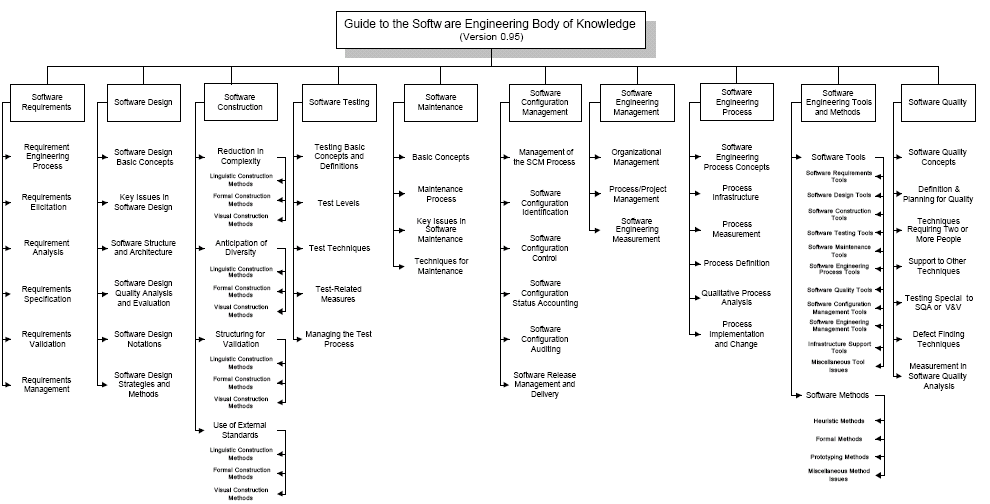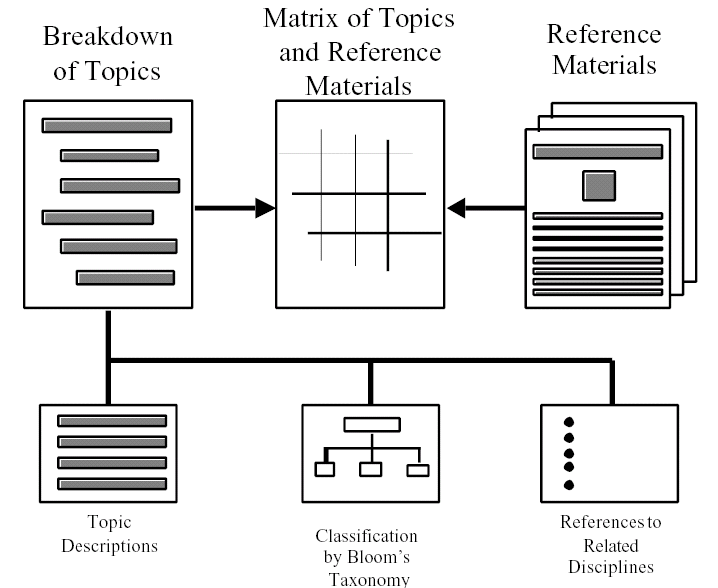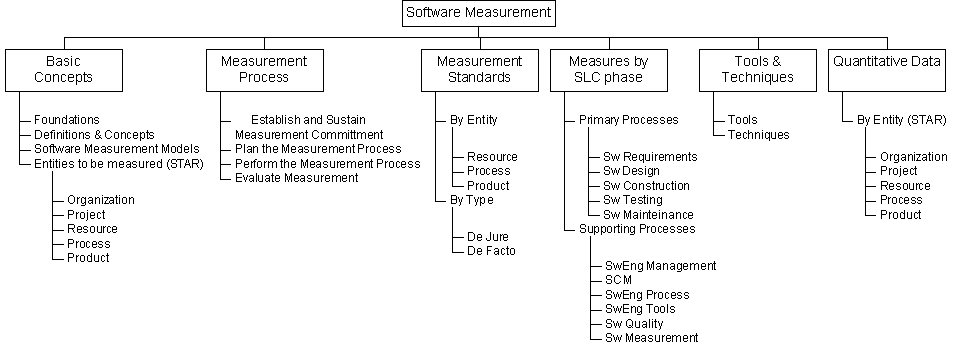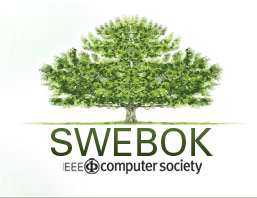
 |
||||||||||||||||
|
SWEBOK framework One of the key projects specifically designed to contribute to the recognition of Software Engineering as a bona fide engineering discipline is the "Guide to the Software Engineering Body of Knowledge" (SWEBOK). This project has been sponsored by the IEEE Computer Society and supported by a consortium of industrial sponsors. The main goal of the SWEBOK was to develop an international consensus on the "generally accepted knowledge" in the Software Engineering domain. The relevance of the SWEBOK has been recently enhanced by its acceptance as an ISO technical report (ISO/IEC TR 19759:2004). This Guide to the SWEBOK was developed in a three-phase approach:  1st release: Straw Man version - 1997, 1st release: Straw Man version - 1997,
 2nd release: Stone Man version (also referred to as the Trial Version - 2001, 2nd release: Stone Man version (also referred to as the Trial Version - 2001,
 3rd release: Iron Man version - 2004 (freely available on the SWEBOK website as well as from the IEEE Computer Society website) 3rd release: Iron Man version - 2004 (freely available on the SWEBOK website as well as from the IEEE Computer Society website)
The Guide to the SWEBOK documents the consensus on the structure of the relevant software engineering knowledge, which consists of ten (10) Knowledge Areas (KAs): the first five KAs represent what the ISO calls the primary processes in the 12207 standard, and, the other five KAs the support and organizational processes. 
(click to enlarge the image) The KAs have a common architecture, as illustrated in the next figure. 
(click to enlarge the image) Main objectives As stated in Chapter 1 of the Guide, SWEBOK has five objectives 1. To promote a consistent view of software engineering worldwide 2. To clarify the place–and set the boundary–of software engineering with respect to other disciplines such as computer science, project management, computer engineering, and mathematics 3. To characterize the contents of the software engineering discipline 4. To provide a topical access to the Software Engineering Body of Knowledge 5. To provide a foundation for curriculum development and for individual certification and licensing material Bloom's taxonomy Bloom's taxonomy is a well-known and widely used classification of cognitive educational goals, developed in 1956. Benjamin Bloom identified six levels, from the simple recall or recognition of facts till their evaluation:  Knowledge: recall data Knowledge: recall data
 Understanding: understand the meaning, translation, interpolation, and interpretation of instructions and problems; state a problem in one's own words Understanding: understand the meaning, translation, interpolation, and interpretation of instructions and problems; state a problem in one's own words
 Application: use a concept in a new situation or use an abstraction unprompted; apply what was learned in the classroom to novel situations in the workplace Application: use a concept in a new situation or use an abstraction unprompted; apply what was learned in the classroom to novel situations in the workplace
 Analysis: separate materials or concepts into components parts so that its organizational structure may be understood; distinguish between facts and inferences Analysis: separate materials or concepts into components parts so that its organizational structure may be understood; distinguish between facts and inferences
 Synthesis: build a structure or pattern from divrese elements; put parts together to form a whole, with enphasis on creating a new meaning or structure Synthesis: build a structure or pattern from divrese elements; put parts together to form a whole, with enphasis on creating a new meaning or structure
 Evaluation: make judgements about the value of ideas or materials Evaluation: make judgements about the value of ideas or materials
Some links on the Bloom's taxonomy:  The SWEBOK Appendix D, on the Classification of topics in the Guide according to Bloom's Taxonomy The SWEBOK Appendix D, on the Classification of topics in the Guide according to Bloom's Taxonomy
 The taxonomy and associated questions The taxonomy and associated questions
 Learning Skills Program Learning Skills Program
 Critical and Creative Thinking Critical and Creative Thinking
Right now, each item within a certain KA has a unique rating, matching with a unique viewpoint that's a "generalist" software engineering viewpoint, where no topic is assigned a taxonomy level higher than "Analysis" (Level 3). In 2003 at ETS we proposed a possible future extension of this schema, with different levels according to three Software Engineers' Profiles, because more close to everyday reality and to multiple exigencies in adapting the initial rating to different skills and professional levels in using the Guide. Some experiences with SWEBOK Now it follows a series of studies, publications, experiences and next events referred to this IEEE Guide...  1st workshop on SWEBOK Evolutions in COMPSAC2005, Edimburgh (UK), 25-28 July 2005 1st workshop on SWEBOK Evolutions in COMPSAC2005, Edimburgh (UK), 25-28 July 2005
 A paper from Mary and Thomas Poppendieck about OO Project Management A paper from Mary and Thomas Poppendieck about OO Project Management
 A presentation about SWEBOK compared to the Univ.of Ottawa Undergraduate SE program A presentation about SWEBOK compared to the Univ.of Ottawa Undergraduate SE program
 An overview of trial usages in the field of education provided at the 33rd ASEE/IEEE Frontiers in Education Conference An overview of trial usages in the field of education provided at the 33rd ASEE/IEEE Frontiers in Education Conference
 An ontology view on quality concepts in the SWEBOK An ontology view on quality concepts in the SWEBOK
 A paper from Richard Fairley and Leonard Tripp about "moving from craft to profession" A paper from Richard Fairley and Leonard Tripp about "moving from craft to profession"
 The DoIT project by the Monash University (Australia) The DoIT project by the Monash University (Australia)
 The SWEBOK Project started as a joint project by IEEE and ACM. During the 2000 ACM decided to keep out from it; this is the final thoughts produced, as well as the full report The SWEBOK Project started as a joint project by IEEE and ACM. During the 2000 ACM decided to keep out from it; this is the final thoughts produced, as well as the full report
 Relationships between SWEBOK and SEEK initiatives for Software Maintenance and Evolution Relationships between SWEBOK and SEEK initiatives for Software Maintenance and Evolution
 An experience at the Dresden University of Technology An experience at the Dresden University of Technology
 A paper from Timothy Lethbridge about the importance of knowledge from practitioners A paper from Timothy Lethbridge about the importance of knowledge from practitioners
 Some thoughts about the way for organizing Software Engineering knowledge Some thoughts about the way for organizing Software Engineering knowledge
 A paper about the opportunity to promote Software Engineering knowledge through the Intranets A paper about the opportunity to promote Software Engineering knowledge through the Intranets
 Using SWEBOK for Education Programs in Industry and Academia by D.Frailey & J.Mason Using SWEBOK for Education Programs in Industry and Academia by D.Frailey & J.Mason
 A gap analysis between knowledge and skills in academic programs by S.Ludi & J.Collofello A gap analysis between knowledge and skills in academic programs by S.Ludi & J.Collofello
 Guidelines from IEEE for evolution of SWEBOK (dated Nov2003) Guidelines from IEEE for evolution of SWEBOK (dated Nov2003)
 An analysis by O.Benediktsson about the usage of SWEBOK for developing curricula An analysis by O.Benediktsson about the usage of SWEBOK for developing curricula
 SWEBOK: adjustments for education, that's a CSEET2003 paper by R.Dupuis & P.Bourque SWEBOK: adjustments for education, that's a CSEET2003 paper by R.Dupuis & P.Bourque
 An IEEE viewpoint on Software Engineering Standards and Certifications An IEEE viewpoint on Software Engineering Standards and Certifications
...as well as some concerns:  about HCI issues missing in curricular guidelines, by G.van der Veer and H.van Vliet about HCI issues missing in curricular guidelines, by G.van der Veer and H.van Vliet
 from Doug Hoffman, Martin Fowler and Cem Kaner from Doug Hoffman, Martin Fowler and Cem Kaner
SWEBOK and Measurement In the Guide to the SWEBOK, there are also some common themes, cutting across most KAs, such as Quality, Tools and Measurement. Two of these have as well been recognized as distinct KAs of their ownin themselves, that is, “Quality and Tools”. Measurement, however, did not make it as a distinct KA. In this paper we explore reasons why the measurement theme has did not beenget recognized as a KA, and we propose contributions that hopefully will lead to the recognitionzing of software measurement a KA in its own right. Measurement is, of course, fundamental to the engineering disciplines and, on these grounds, it had been given as an editorial criteria to the all of the KA associate editors as an criterion for identifying relevant generally accepted knowledge in their respective KAs. However, distinct associate editors initially developed each of the 10 KAs individually, which this led to different levels of breadth and depth of treatment of a sub-topic such as measurement. Furthermore, measurement-related knowledge has not been developed equally across KAs over the recent history of software engineering. One possibility illustrated in the Appendix B of the Guide is in fact is the possibility of evolution of the Guide, describing the process for introducing or modifying its current version. In July 2005, referred to this possibility, it will take place SWEBOK'05, that's a dedicated workshop within COMPSAC'05. A proposal of Software Measurement Body of Knowledge An initial, unified view of the measurement knowledge in software engineering was proposed by Buglione and Abran at the beginning of 2004 in the form of a distinct KA on Software Measurement, taking into account all the measurement-related items from the existing KAs in the 2001 edition of the Guide to the SWEBOK and organizing them into an initial breakdown. In 2003-2004, Guide to the SWEBOK went through its Iron Man revision. Various contributors have added measurement- related knowledge, including in some KAs where treatment of measurement had been initially been fairly weak, such as in the Construction KA. Within this review cycle, a specific proposal for the addition of a new KA had been proposed by two of the international reviewers, but such these proposals were not accepted on the basis that this measurement was had not yet become generally accepted in the software engineering community, and that no detailed structure had yet been validated by the community of peers in the software engineering measurement community. After an analysis against the Vincenti's classification of engineering knowledge types, we noted that the Quantative Data (QD) area was not covered. Here in the following the derived taxonomy for the new KA: 
(click to enlarge the image) Next step will be the experimental support analysis of the proposal of new KA according to the "experimentation" taxonomy by Zelkowitz & Wallace, examining the nature of references retrieved by the measurement topics contained and extracted from existing KAs and proposing new ones where missing. In particular, a dedicated workshop (SMEKA/SWEBOK) was held in late 2007 within IWSM/MENSURA 2007 conference. Now the draft KA can be downloaded directly from the SWEBOK website. Publications  L.Buglione Misurare il software. Quantità, Qualità, Standards e Miglioramento di processo nell'Information & Communication Technology, 3rd Edition, Franco Angeli, 2008 (Chapter 1) L.Buglione Misurare il software. Quantità, Qualità, Standards e Miglioramento di processo nell'Information & Communication Technology, 3rd Edition, Franco Angeli, 2008 (Chapter 1)
 L.Buglione, A.Abran & F.Coallier, A revision of of the knowledge classification in three SWEBOK chapters: Management, Process and Quality, STEP 2003, Workshop on the Expected Levels of Understanding of SWEBOK Topics, September 19-21, 2003, Amsterdam (Netherlands) L.Buglione, A.Abran & F.Coallier, A revision of of the knowledge classification in three SWEBOK chapters: Management, Process and Quality, STEP 2003, Workshop on the Expected Levels of Understanding of SWEBOK Topics, September 19-21, 2003, Amsterdam (Netherlands)
 L.Buglione Aspetti di misurazione in SWEBOK (Software Engineering Body of Knowledge), Gruppo Utenti Function Point Italia - Italian Software Metrics Association (GUFPI-ISMA), Rome (Italy), 17 July 2003, Presentation L.Buglione Aspetti di misurazione in SWEBOK (Software Engineering Body of Knowledge), Gruppo Utenti Function Point Italia - Italian Software Metrics Association (GUFPI-ISMA), Rome (Italy), 17 July 2003, Presentation
 Buglione L., SQA: competenza e addestramento nello SWEBOK, Atti del XXI Convegno Nazionale AICQ "Qualità oggi: cosa cambia, contributi per capire", Roma 10 Novembre 2003 Buglione L., SQA: competenza e addestramento nello SWEBOK, Atti del XXI Convegno Nazionale AICQ "Qualità oggi: cosa cambia, contributi per capire", Roma 10 Novembre 2003
 P.Bourque, L.Buglione, A.Abran & A.April, Bloom's Taxonomy Levels for Three Software Engineer Profiles, STEP 2003, Workshop on the Expected Levels of Understanding of SWEBOK Topics, September 19-21, 2003, Amsterdam (Netherlands), Post-Conference Proceedings, pp.123-129 P.Bourque, L.Buglione, A.Abran & A.April, Bloom's Taxonomy Levels for Three Software Engineer Profiles, STEP 2003, Workshop on the Expected Levels of Understanding of SWEBOK Topics, September 19-21, 2003, Amsterdam (Netherlands), Post-Conference Proceedings, pp.123-129
 L.Buglione & A.Abran, The Software Measurement Body of Knowledge , Proceedings of
SMEF 2004, Software Measurement European Forum, January 28-30 2004, Rome (Italy), ISBN 88-86674-33-3, pp.84-94 L.Buglione & A.Abran, The Software Measurement Body of Knowledge , Proceedings of
SMEF 2004, Software Measurement European Forum, January 28-30 2004, Rome (Italy), ISBN 88-86674-33-3, pp.84-94
 A.Abran, L.Buglione & A.Sellami, Software Measurement Body of Knowledge - Initial
Validation using Vincenti's Classification of Engineering Knowledge types, in "Software Measurement - Research and Application", Proceedings of the IWSM 2004 / MetriKon 2004 Software Metrik Kongress, 14th International Workshop on Software Measurement and Metrik Kongress, November 2-5, 2004, Konigs Wusterhausen (Germany), Shaker Verlag, ISBN 3-8322-3383-0, pp. 255-270 A.Abran, L.Buglione & A.Sellami, Software Measurement Body of Knowledge - Initial
Validation using Vincenti's Classification of Engineering Knowledge types, in "Software Measurement - Research and Application", Proceedings of the IWSM 2004 / MetriKon 2004 Software Metrik Kongress, 14th International Workshop on Software Measurement and Metrik Kongress, November 2-5, 2004, Konigs Wusterhausen (Germany), Shaker Verlag, ISBN 3-8322-3383-0, pp. 255-270
 L.Buglione & A.Abran, Software Measurement Body of Knowledge - Overview of Empirical Support, in "Innovations in Software Measurement", Proceedings of the 15th International Workshop on Software Measurement (IWSM 2005), 12-14 September 2005, Montréal (Canada), Shaker Verlag, ISBN 3-8322-4405-0, pp. 353-368 L.Buglione & A.Abran, Software Measurement Body of Knowledge - Overview of Empirical Support, in "Innovations in Software Measurement", Proceedings of the 15th International Workshop on Software Measurement (IWSM 2005), 12-14 September 2005, Montréal (Canada), Shaker Verlag, ISBN 3-8322-4405-0, pp. 353-368
External References  Sellami A., Processus de Vérification des mesures de logiciels selon la perspective de Métrologie , Ph.D. Thesis, Ecole de Technologie Superieure (ETS), Montréal, 19 October 2005
Sellami A., Processus de Vérification des mesures de logiciels selon la perspective de Métrologie , Ph.D. Thesis, Ecole de Technologie Superieure (ETS), Montréal, 19 October 2005
 Moutin Segoria Gasparotto A., Proposta de um modelo para gestão de processo aplicado a empresas de base tecnológica organizadas em Cluster, Universidade de São Paulo, Escola de Engenharia de São Carlos, Qualificação para el título de Doutora em Engenharia de Produção, 2006
Moutin Segoria Gasparotto A., Proposta de um modelo para gestão de processo aplicado a empresas de base tecnológica organizadas em Cluster, Universidade de São Paulo, Escola de Engenharia de São Carlos, Qualificação para el título de Doutora em Engenharia de Produção, 2006
 Mutafelija B. & Stromberg H., Architecting Processes with SWEBOK and CMMI, SEPG 2006 Conference, March 2006
Mutafelija B. & Stromberg H., Architecting Processes with SWEBOK and CMMI, SEPG 2006 Conference, March 2006
 Zhu L., Ikeda M., Ochimizu L., A Context and Viewpoint Oriented Software Engineering Body of Knowledge based ontology, The 21st Annual Conference of the Japanese Society for Artificial Intelligence, 2007, (In Japanese)
Zhu L., Ikeda M., Ochimizu L., A Context and Viewpoint Oriented Software Engineering Body of Knowledge based ontology, The 21st Annual Conference of the Japanese Society for Artificial Intelligence, 2007, (In Japanese)
 Azuma M., Coallier F., Garbajosa J., How to apply the Bloom taxonomy to software engineering, 11th Annual International Workshop on Software Technology and Engineering Practice (STEP 2003), Sep 19-21 2003, pp. 117- 122, ISBN: 0-7695-2218-1
Azuma M., Coallier F., Garbajosa J., How to apply the Bloom taxonomy to software engineering, 11th Annual International Workshop on Software Technology and Engineering Practice (STEP 2003), Sep 19-21 2003, pp. 117- 122, ISBN: 0-7695-2218-1
 Diaz M., Garcia F., Piattini M., Defining, Performing and Maintaining Software Measuremetn Programs: State of the Art, Actas del IV Simposio Internacional de Informacion e Ingegneria de Software en la Socied del Conocimiento (SISOFT2006), Vol. I, Cartagena de Indias (Colombia), August 23-25 2005, pp.13-23
Diaz M., Garcia F., Piattini M., Defining, Performing and Maintaining Software Measuremetn Programs: State of the Art, Actas del IV Simposio Internacional de Informacion e Ingegneria de Software en la Socied del Conocimiento (SISOFT2006), Vol. I, Cartagena de Indias (Colombia), August 23-25 2005, pp.13-23
 Naslia Khairuddin N., Hasim K., Application of Bloom’s Taxonomy in Software Engineering Assessments, Proceedings of the 8th WSEAS Int. Conf.on Applied Computer Science (ACS'08), Venice (Italy), 2008, pp.66-69
Naslia Khairuddin N., Hasim K., Application of Bloom’s Taxonomy in Software Engineering Assessments, Proceedings of the 8th WSEAS Int. Conf.on Applied Computer Science (ACS'08), Venice (Italy), 2008, pp.66-69
 Suryn W., Stambollian A., Dormeux J.C., Bégnoche L., Software Quality Engineering – where to find it in Software Engineering Body of Knowledge (SWEBOK), Proceedings of 14th International Software Quality Management & INSPIRE Conference 2006, Southampton, Hampshire, UK 10-12 April 2006
Suryn W., Stambollian A., Dormeux J.C., Bégnoche L., Software Quality Engineering – where to find it in Software Engineering Body of Knowledge (SWEBOK), Proceedings of 14th International Software Quality Management & INSPIRE Conference 2006, Southampton, Hampshire, UK 10-12 April 2006
 I. Bluemke and A. Derezinska, Internet Laboratory Instructions for Advanced Software Engineering Course, in "Software Engineering: Evolution and Emerging Technologies", K. Zielinski and T. Szmuc (Eds.), IOS Press, 2005, pp-160-171 I. Bluemke and A. Derezinska, Internet Laboratory Instructions for Advanced Software Engineering Course, in "Software Engineering: Evolution and Emerging Technologies", K. Zielinski and T. Szmuc (Eds.), IOS Press, 2005, pp-160-171
|
|

